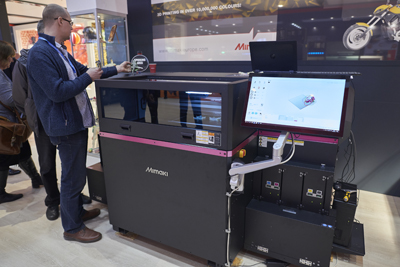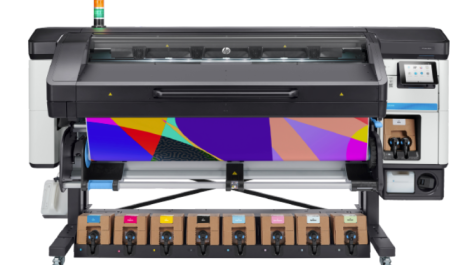Mimaki developed the 3DUJ-P printer and the associated software that goes with it
3D printing is becoming more prevalent as the technology evolves but is it time for digital printers to invest in this market, asks Nessan Cleary.
In truth, there isn’t much actual “printing” involved in 3D printing, though there are quite a few wide-format printer vendors that are also developing 3D printers and some of these do use inkjet printheads. The phrase ‘3D printing’ is more of an umbrella term that covers several different technologies that have evolved over the last 30 years or so and are now routinely used for creating prototypes, as well as manufacturing tools, jigs and moulds. More recently, as the materials have opened up to include metals, ceramics and toughened plastics so this approach is increasingly being used for short-run manufacturing of end-use parts. There’s also a growing consumer market for items such as spectacles and earbuds, which can be made from a scan of an individual customer face or ears for truly personalised printing.
There’s not much crossover between 2D and 3D printing, though Peter Kettle, business development manager at Roland DG, says that 3D printing can be used for making prototypes of packaging such as perfume or water bottles. Roland has taken an interesting approach, developing both a desktop milling machine for “subtractive” manufacturing (where you start with a block of material and remove the parts you don’t want), and a 3D printer for “additive” manufacturing (in which the desired object is built up, usually in layers, sometimes with a supporting medium that’s removed at the end of the process), which are often sold as a complementary pair. Mr Kettle says that milling can give better accuracy and a nicer surface finish, adding, ‘It’s quicker, easier and cheaper to produce things like packaging mock-ups with milling. But they might 3D print the cap with the special pouring mechanism.’

A mould, created on a Stratasys 3D printer, to produce a prototype for a bottle
Light sliced
Roland DG’s 3D printer is the ARM10, which uses digital light processing (DLP), whereby the object is first split into slices or layers and each layer is then projected onto a vat of photopolymer resin; where the light reacts with the resin, it hardens to form the layer. The base is then lowered and the next layer is projected on top of this until the object is built up one layer at a time. The bed is 70 x 130mm and objects can be 70mm tall. This is complemented by the SRM20 milling machine, which can handle a wide range of materials such as modelling wax, wood, acrylic and ABS.
The DLP process is particularly suited to smaller objects such as jewellery. Roland has also developed a number of 3D DLP printers that are aimed specifically at the dental market, which has been an early adopter of 3D printing, mainly because of the need to produce things such as bridges and implants that are tailored to individual patients.
Mimaki recently announced its first 3D printer, the 3DUJ-P. This uses a form of LED UV-curable ink to build up the 3D objects. It prints in six colours – CMYK plus white and clear – so that the objects have the full colour gamut that we would normally associate with a UV printer with over 10 million colours. Mimaki claims that it can reproduce 84 percent of the Fogra 39L colour gamut, which is considerably more than most other 3D printers.
The ink cures layer by layer to form an acrylic resin modelling material. The printer also lays down a dissolvable resin to support the object while it’s being printed, which is also cured by LED UV light. Once the object is printed, the support can be dissolved in a water wash and the UV object peeled away. There’s no need for any further cleaning or polishing. The objects are solid enough that you can insert screws into them without risk of breakage.
There are eight separate printheads, with two being used for the support resin, one for white, one for clear and the remaining for the CMYK inks. The print heads use variable dot control, which delivers fairly detailed objects. The heads themselves use ink recirculation to help prevent nozzle blocking and there’s a system to detect and recover blocked nozzles.
It has a build area of 500 x 500 x 300mm. Ronald van den Broek, general manager for Mimaki Europe, says that it can be used to add more dimensions to sign graphics and even for production of items such as buttons. But the main market is clearly prototyping, particularly for architecture and designers making samples where the hope is that the wider colour gamut will give it an edge.

The Massivit 1800 3D printer is suitable for creating objects for marketing displays
Big it up
The Israeli company Massivit, founded by a team that previously worked at Idanit and Scitex Vision, has developed a 3D printer, the Massivit 1800, that specifically targets large format point-of-sale advertising and brand marketing. This is a big machine, with a printing volume of 1.5 x 1.2 x 1.8m, which can be used to produce large objects, such as life-sized statues.
It works by extruding a gel-like photopolymer acrylic-based material one layer at a time that solidifies with exposure to UV. Once hardened the material is quite brittle but dimensionally stable so that there’s little need to print any supports or in-fill.
Massivit claims that it can print and cure at a speed of around 35cm (height) per hour. This translates into roughly five hours to produce a life size sculpture of a standing human, though the speed is heavily dependent on the shape of the object. It’s usually configured with two heads, so in that time you could print two human sculptures side by side.
A number of large format printers have installed the Massivit machine, including Pictrographics in Las Vegas, USA, a family run business specialising in sign and display services. Craig Miller, Pictographics’ president & CEO, explains, ‘With the capability to 3D print attention-grabbing display projects, the Massivit 1800 will significantly strengthen our applications offering, unlock new business opportunities and enhance our competitive edge. The system has been easy to integrate into our production site and the impact it will have will be, well… massive.’

Mimaki’s 3D printer allows “full colour” printing of display and promotional items
The Dutch company Leapfrog was set up by AV Flexologic, which makes products such as flexo platemaking and sleeve mounting equipment for packaging converters. Leapfrog grew out of an internal project within AV Flexologic to look at ways of producing short runs of customised parts. The latter now uses 3D printing to manufacture parts for some of its machinery, such as air splitters, which are small but quite specialised components.
Leapfrog’s latest printer is the Bolt Pro, a compact desktop machine that’s aimed at professional users.
Leapfrog also developed the Xcel for another company in the AV Flexologic group, Tech Sleeves, which makes sleeves and bridges for flexo presses. The Xcel can produce a full size core for a flexo sleeve, which can be printed on demand and customised for the exact configuration of the flexo press at each customer site.
HP has developed the Multi Jet Fusion range of 3D printers, which use a form of laser sintering and work with plastic materials supplied in powder form. The powder is laid down first and then two liquid agents are added to define the object. The first of these is a coalescing agent that causes the powder to be fused when it’s hit by a laser, while the second agent is for modifying the powder, adding other properties. This includes features such as preventing the powder from fusing, which would be handy if you were trying to create an intricate shape or a hollow area.
The liquid agents are jetted through HP’s thermal printheads – essentially the same printheads that are used in all its inkjet printers from desktop to commercial printers. Once the liquid agents have been jetted, a laser then fuses the powder where the liquid agent has created a pattern. The unused layer is brushed off and recycled back into the system. The whole process is then repeated layer by layer to create a complete object.
As well as the printer, there’s a separate unit for materials preparation and processing. The powder is loaded into the processing unit, which mixes it and loads it into the build unit. This build unit is mounted on wheels so it can be moved into the printer for the printing and fusing stage and then moved back to the processing unit where it’s cooled, the unused powder is recycled and the printed parts are unloaded, thus leaving the printer free to start the next job.
There are several models starting with the 3200, which has a build speed of 3500cm3/hr and is aimed mainly at prototyping. There’s also a 4200, with a build speed of 4500cm3/hr, which targets short run production, and the most recent addition, the 4210, which is faster and can handle slightly longer production runs.

This life-size figure of Italian comic book character Corto Maltese was produced by Massivit customer Paris-based Metropole
Identify the opportunity
So, why should graphics print service providers be interested in additive manufacturing? Well, why not? Most printers are ideally positioned to offer 3D printing as a bureau service. For a start, printers are used to dealing with CAD files and with the need to verify those files and have them approved by customers. They’re already manufacturing items on-demand, be that direct mail leaflets or POS displays so 3D printing is a relatively easy way of diversifying the business.
This is particularly true of wide-format printers, who may already be producing 3D retail displays, and like the wide-format market, there’s a wide range of price points – from a few hundred pounds to hundreds of thousands – and specific applications to consider. The trick is to understand the immediate market and which technology to invest in, for prototyping or for manufacturing. But make no mistake – over the coming decades 3D printing will become as much a part of our lives as the Internet is today.





